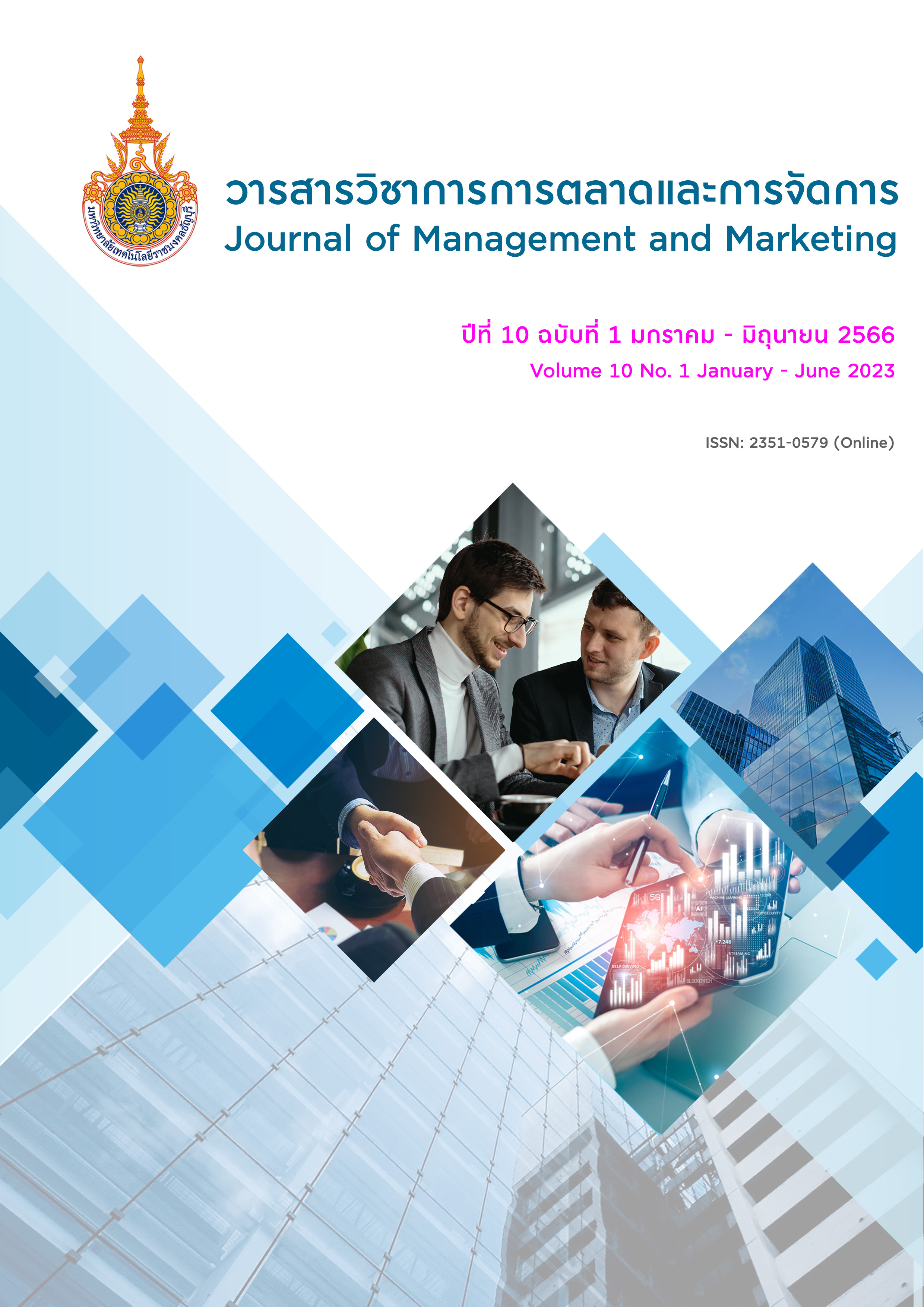นวัตกรรมการบริการและผลประโยชน์เชิงสัมพันธ์ของแอปพลิเคชันจัดส่งอาหารที่ส่งผลต่อความภักดีโดยผ่านความพึงพอใจของลูกค้า
คำสำคัญ:
นวัตกรรมการบริการ , ผลประโยชน์เชิงสัมพันธ์ , ความพึงพอใจของลูกค้า , ความภักดีของลูกค้า , แอปพลิเคชันจัดส่งอาหารบทคัดย่อ
งานวิจัยนี้มีวัตถุประสงค์เพื่อศึกษาอิทธิพลของนวัตกรรมการบริการ (Service innovation) ผลประโยชน์เชิงสัมพันธ์ (Relational benefit) และความพึงพอใจของลูกค้าที่ส่งผลต่อความภักดีของลูกค้าในธุรกิจแอปพลิเคชันจัดส่งอาหาร และเพื่อศึกษาอิทธิพลของความพึงพอใจของลูกค้าในฐานะตัวแปรคั่นกลาง ระหว่างนวัตกรรมการบริการและผลประโยชน์เชิงสัมพันธ์ที่ส่งผลต่อความภักดีของลูกค้า โดยได้ศึกษาจากกลุ่มตัวอย่างผู้บริโภคที่เคยใช้บริการแอปพลิเคชันจัดส่งอาหาร จำนวนทั้งสิ้น 425 คน ผู้วิจัยใช้วิธีการสุ่มตัวอย่างแบบเฉพาะเจาะจง (Purposive sampling) เครื่องมือที่ใช้ในการวิจัย คือ แบบสอบถามออนไลน์ สถิติที่ใช้ในการวิเคราะห์ ประกอบด้วย การวิเคราะห์ถดถอยพหุคูณ และการวิเคราะห์เส้นทาง
ผลการศึกษา พบว่า เมื่อพิจารณาจากอิทธิพลโดยรวมทั้งทางตรงและทางอ้อม ปัจจัยที่ส่งผลต่อความภักดีมากเป็นอันดับแรก คือ ผลประโยชน์เชิงสัมพันธ์ (0.688) รองลงมา คือ นวัตกรรมการบริการ (0.595) และความพึงพอใจของลูกค้า (0.549) ตามลำดับ โดยความพึงพอใจของลูกค้าเป็นตัวแปรคั่นกลาง
ที่มีอิทธิพลบางส่วน (Partial mediation) ในความสัมพันธ์ของนวัตกรรมการบริการ ผลประโยชน์เชิงสัมพันธ์ และความภักดีของลูกค้า โดยผลการศึกษาทั้งหมดเป็นไปตามสมมติฐาน ผลงานวิจัยนี้ช่วยเพิ่มพูนองค์ความรู้ทฤษฎีด้านการตลาดบริการและเป็นประโยชน์ต่อผู้ประกอบการธุรกิจแอปพลิเคชันจัดส่งอาหาร เพื่อใช้ในการพัฒนานวัตกรรมการบริการและผลประโยชน์เชิงสัมพันธ์ของธุรกิจให้ตอบสนองความพึงพอใจของลูกค้า ซึ่งจะนําไปสู่ความสัมพันธ์ในระยะยาวที่ยั่งยืนกับธุรกิจ
เอกสารอ้างอิง
จิตระวี ทองเถา. (2561). รูปแบบความสัมพันธ์เชิงสาเหตุที่มีผลต่อความภักดีของลูกค้าในการใช้ระบบ โทรศัพท์เคลื่อนที่ในประเทศไทย. Journal of Business Administration The Association of Private Higher Education Institutions of Thailand, 7(2), 124-137.
ชีวสิทธิ วีระเมธีกุล. (2562). การยกระดับตราสินค้าการท่องเที่ยวด้วยการตลาดเชิงรุกและนวัตกรรมการบริการ. การประชุมวิชาการระดับชาติและนานาชาติ มหาวิทยาลัยศรีปทุม ครั้งที่ 14. กรุงเทพฯ: มหาวิทยาลัยศรีปทุม.
ศูนย์วิจัยกสิกร. (2566). ทิศทาง Food Delivery ปี 66? หลังผู้บริโภคกลับมาใช้ชีวิตปกติ. สืบค้นจาก https://www.kasikornresearch.com/th/analysis/k-social- media/Pages/ FoodDelivery-FB-05-01-2023.aspx
โสรยา สุภาผล. (2565). ภาพลักษณ์องค์กรและนวัตกรรมที่ส่งผลต่อความภักดีของผู้ใช้บริการบริษัท ไปรษณีย์ไทยจำกัด. วารสารวิชาการศรีปทุม ชลบุรี, 18(4), 76-88.
อนิรุทธิ์ เจริญสุข. (2565). แบบจำลองการจัดการนวัตกรรมการบริการสำหรับธุรกิจโรงแรมในประเทศไทย. วารสารสังคมศาสตร์, 11(2), 98-113.
อุทัยวรรณ สุกิมานิล. (2565). แนวทางการพัฒนานวัตกรรมการบริการสุขภาพและแรงสนับสนุนทางสังคม ในการพยาบาลชุมชนเพื่อส่งเสริมสุขภาพผู้สูงอายุอย่างยั่งยืน. วารสารสันติศึกษา ปริทรรศน์ มจร., 10(4), 1827-1839.
Alalwan, A. A. (2018). Investigating the impact of social media advertising features on customer purchase intention. International Journal of Information Management, 42, 65-77.
Ameme, B., & Wireko, J. (2016). Impact of technological innovations on customers in the banking industry in developing countries. The Business & Management Review, 7(3), 388.
Annaraud, K., & Berezina, K. (2020). Predicting satisfaction and intentions to use online food delivery: What really makes a difference?. Journal of Foodservice Business Research, 23(4), 305-323.
Assauri, S. (2012). Strategic Marketing: Sustaining Lifetime Customer Value. Jakarta: Rajawali Pers.
Belanche, D., Casaló, L. V., Flavián, C., & Schepers, J. (2020). Service robot implementation: a theoretical framework and research agenda. The Service Industries Journal, 40(3-4), 203-225.
Berry, L. L. (1983). Relationship marketing. Emerging perspectives on services marketing, 66(3), 33-47.
Best, J. W., & Kahn, J. V. (2016). Research in education. India: Pearson Education.
Bloch, C., & Aagaard, K. (2007). Mapping Innovation Policy in Services Country Report- Denmark. Paper for the ServINNO project–Service Innovation in the Nordic Countries: Key Factors for Policy Design. Retrieved from https://www.researchgate.net/publication/237214954_Mapping_Innovation_Policy_in_Services_Country_Report_-_Denmark
Bolton, R. N., & Drew, J. H. (1994). Linking customer satisfaction to service operations and outcomes. Service quality: New directions in theory and practice, 3(2), 173-200.
Bowen, J.T., Shoemaker, S. (1998). Loyalty: a strategic commitment. The Cornell Hotel and Restaurant Administration Quarterly, 39(1), 12-25.
Chakraborty, S., & Sengupta, K. (2014). Structural equation modelling of determinants of customer satisfaction of mobile network providers: Case of Kolkata, India. IIMB Management Review, 26(4), 234-248.
Chaudhuri, A., Holbrook, M. B. (2001). The chain of effects from brand trust and brand affect to brand performance: the role of brand loyalty. Journal of Marketing, 65(2), 81-93.
Cochran, W. G. (1977). Sampling techniques. Companies, New York: John Wiley & Sons.
Dagger, T. S., & O'Brien, T. K. (2010). Does experience matter? Differences in relationship benefits, satisfaction, trust, commitment and loyalty for novice and experienced service users. European Journal of Marketing, 44(9/10), 1528-1552.
Daryanto, D. (2014). Pendekatan pembelajaran saintifik Kurikulum 2013. Yogyakarta: Gava Media.
Den Hertog, P., Van der Aa, W., & De Jong, M. W. (2010). Capabilities for managing service innovation: towards a conceptual framework. Journal of service Management, 21(4), 490-514.
Dick, A.S., Basu, K. (1994). Customer loyalty: toward an integrated conceptual framework. Journal of the Academy of Marketing Science, 22(2), 99-113.
Faiz, G. (2002). Innovation in the service economy: The new wealth of nations. Research Policy, 32(9), 1716-1717.
Ferryanto, L. (2006). Why is quality job No. 1?. Lean & Six Sigma Review, 5(2), 22-25.
Fornell, C. (1992). A national customer satisfaction barometer: The Swedish experience. Journal of marketing, 56(1), 6-21.
Greenland, K., & Looney, W. (2007). Secondary market offers another option to manage loan portfolios. Com. Lending Rev., 22, 35.
Griffith, M. (2015). Item Analysis with Cronbach's Alpha for Reliable Surveys. Retrieved from https://blog.minitab.com/en
Gwinner, K. P., Gremler, D. D., & Bitner, M. J. (1998). Relational benefits in services industries: the customer’s perspective. Journal of the academy of marketing science, 26, 101-114.
Hague, P., & Hague, N. (2016). Customer Satisfaction Survey: The customer experience through the customer’s eyes. London: Cogent Publication.
Hennig-Thurau, T., Gwinner, K. P., & Gremier, D. D. (2002). Understanding relationship marketing outcomes. Journal of Service Research, 4(3), 230-247.
Hoffmann, A. O., & Birnbrich, C. (2012). The impact of fraud prevention on bank- customer relationships: An empirical investigation in retail banking. International journal of bank marketing, 30(5), 390-407.
Kahn, K. B. (2018). Understanding innovation. Business Horizons, 61(3), 453-460.
Kim, W. G., Lee, S., & Lee, H. Y. (2007). Co-branding and brand loyalty. Journal of Quality Assurance in Hospitality & Tourism, 8(2), 1-23.
Kotler, P., & Pfoertsch, W. (2007). Being known or being one of many: the need for brand management for business-to-business (B2B) companies. Journal of business & industrial marketing, 22(6), 357-362.
Kumar, V., Umashankar, N., Kim, K. H., & Bhagwat, Y. (2014). Assessing the influence of economic and customer experience factors on service purchase behaviors. Marketing Science, 33(5), 673-692.
Lee, T. H. (2009). A structural model to examine how destination image, attitude, and motivation affect the future behavior of tourists. Leisure sciences, 31(3), 215-236.
Leninkumar, V. (2017). The Relationship Between Customer Satisfaction and Customer Trust on Customer Loyalty. International Journal of Academic Research in Business and Social Sciences, 7(4), 450-465.
Mahmoud, M. A., Hinson, R. E., & Anim, P. A. (2018). Service innovation and customer satisfaction: the role of customer value creation. European Journal of Innovation Management, 21(3), 402-422.
Manual, O. (2005). The Measurement of Scientific and Technological Activities (3rd. ed.). France: OECD.
Mention, A. L. (2012). The impact of innovation on performance in services: Disentangling effects through the lenses of intellectual capital. Arcada University of Applied Sciences Helsinki Finland, 294-301.
Nguyen, N. T., Tran, T. T., and Wang, C. N. (2014). An Empirical Study of CS Towards Bank Payment Card Service Quality in Ho Chi Minh Banking Branches. International Journal of Economics and Finance, 6(5), 170-181.
Patterson, P. G., & Smith, T. (2001). Relationship benefits in service industries: a replication in a Southeast Asian context. Journal of services marketing, 15(6), 425-443.
Pigatto, G., Machado, J. G. D. C. F., Negreti, A. D. S., & Machado, L. M. (2017). Have you chosen your request? Analysis of online food delivery companies in Brazil. British Food Journal, 119(3), 639-657.
Rajapathirana, R. J., & Hui, Y. (2018). Relationship between innovation capability, innovation type, and firm performance. Journal of Innovation & Knowledge, 3(1), 44-55.
Seesaiprai, S. (2016). The Effects of SI and Service Quality on Customer’s Loyalty in Small Service Enterprise: A Case Study on Car Care Business in Bangkok. Review of Integrative Business and Economics Research, 5(1), 296-305.
Sukmawati, R. (2017). Pengaruh Kualitas Produk, Harga Dan Layanan Terhadap Kepuasan Konsumen Garden Cafe Koperasi Mahasiswa. Tugas Skripsi. Universitas Negeri Yogyakarta. Jurnal Pendidikan dan Ekonomi, 7(2), 130-142.
Tam, J.L.M. (2004). Customer satisfaction, service quality and perceived value: an integrative model. Journal of Marketing Management, 20(7/8), 897-917.
Thanh, N. T. K., Vinh, N. Q., & Tuan, N. T. (2020). Relationships among Expectations, Satisfaction and Loyalty of Visitors to Craft Village. WSEAS Transactions on Environment and Development, 16, 776-783.
Troise, C., O'Driscoll, A., Tani, M., & Prisco, A. (2021). Online food delivery services and behavioural intention–a test of an integrated TAM and TPB framework. British Food Journal, 123(2), 664-683.
Tseng, M. L., & Chiu, S. F. (2008). A grey-fuzzy approach to the customer perception of in- flight service quality in domestic airlines, Taiwan. Proceedings of the 9th Asia Pacific industrial engineering & management systems conference (722-745). Nusa Dua, Bali, Indonesia.
Wang, X., Zhang, J., Gu, C., & Zhen, F. (2009). Examining antecedents and consequences of tourist satisfaction: A structural modeling approach. Tsinghua Science and technology, 14(3), 397-406.
Weitz, B. A., & Jap, S. D. (1995). Relationship marketing and distribution channels. Journal of the academy of Marketing Science, 23, 305-320.
Weng, M. H., Ha, J. L., Wang, Y. C. & Tsai, C. L. (2012). A study of the relationship among service innovation customer value and customer satisfaction: an industry in TAIWAN. International Journal of Organizational Innovation, 4(3), 98-112.
Woo, H., Kim, S. J., & Wang, H. (2021). Understanding the role of service innovation behavior on business customer performance and loyalty. Industrial Marketing Management, 93, 41-51.
Wu, C. W. (2014). The Study of SI for Digiservice on Loyalty. Journal of Business Research, 67(5), 819-824.
Wu, H. C., Ai, C. H., & Chang, Y. Y. (2021). What drives experiential persistence intentions: The case of gay tourism. Journal of China Tourism Research, 18(5), 1-27.
Xu, X., Thong, J. Y., & Venkatesh, V. (2014). Effects of ICT service innovation and complementary strategies on brand equity and customer loyalty in a consumer technology market. Information Systems Research, 25(4), 710-729.
YuSheng, K., and Ibrahim, M. (2019). SI, SD and CS and Loyalty in the Banking Sector of Ghana. International Journal of Bank Marketing, 37(5), 1215-1233.
Zameer, H., Wang, Y., Yasmeen, H., & Ahmed, W. (2019). Modeling the role of service quality, customer satisfaction and customer loyalty in building service brand equity. International Journal of Asian Business and Information Management, 10(2), 55-72.
Zeithaml, V. A., Bitner, M. J., & Gremler, D. D. (2006). Services marketing: Integrating customer focus across the firm. McGraw-Hill/Irwin.
Zhao, Y., & Bacao, F. (2020). What factors determining customer continuingly using food delivery apps during 2019 novel coronavirus pandemic period?. International journal of hospitality management, 9, Retrieved from https://doi.org/10.1016/j.ijhm.2020.102683
Zineldin, M. (2006). The royalty of loyalty: CRM, quality and retention. Journal of Consumer Marketing, 23(7), 430-437. Retrieved from https://doi.org/10.1108/07363760610712975
ดาวน์โหลด
เผยแพร่แล้ว
รูปแบบการอ้างอิง
ฉบับ
ประเภทบทความ
สัญญาอนุญาต
ลิขสิทธิ์ (c) 2023 วารสารวิชาการการตลาดและการจัดการ มหาวิทยาลัยเทคโนโลยีราชมงคลธัญบุรี

อนุญาตภายใต้เงื่อนไข Creative Commons Attribution-NonCommercial-NoDerivatives 4.0 International License.
บทความที่ได้รับการตีพิมพ์เป็นลิขสิทธิ์ของ ผู้นิพนธ์
ข้อความที่ปรากฏในบทความแต่ละเรื่องในวารสารวิชาการเล่มนี้เป็นความคิดเห็นส่วนตัวของผู้เขียนแต่ละท่านไม่เกี่ยวข้องกับมหาวิทยาลัยเทคโนโลยีราชมงคลธัญบุรี และคณาจารย์ท่านอื่น ในมหาวิทยาลัยฯ แต่อย่างใด ความรับผิดชอบองค์ประกอบทั้งหมดของบทความแต่ละเรื่องเป็นของผู้เขียนแต่ละท่าน หากมีความผิดพลาดใดๆ ผู้เขียนแต่ละท่านจะรับผิดชอบบทความของตนเองแต่ผู้เดียว









